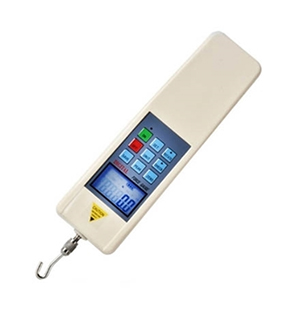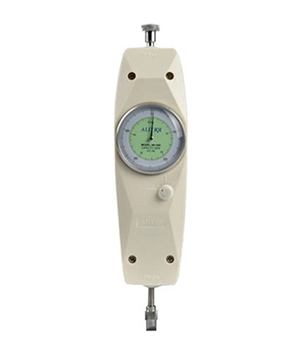What is the Digital Force Gauge?
Digital force gauges are widely used in various industries such as pharmaceuticals, cosmetics, food, packaging, automobiles, electrics, electronics, and machinery. It is an indispensable force measuring tool in product manufacturing, quality management, research, and development. Today,ATO will introduce the digital force gauge in detail, hoping to help you.
Features
The appearance is small and exquisite, and easy to carry. A digital dynamometer needs to be used with some related accessories and is easy to operate. As indicated by the pointer, the reading is very easy and clear, the test results are highly accurate, and some functions can be switched freely. The unit is divided into Newton (N) and kilogram (K), and these optional two units can be freely converted and used at the same time.
To realize the dynamometer, you must first understand its structure and principle. The digital dynamometer is composed of a casing, a sensor, a single-chip circuit board, and a display. The overall structure can be divided into three parts: the first is the connecting piece, the second is the magnifying device part, and the third is the display part. Let's first get to know the component of the resistance strain gauge. The resistance strain gauge is a sensitive device that converts the strain change on the tested part into an electrical signal. When it senses the electrical signal, it will be transmitted to the circuit board of the single-chip microcomputer. When we pull or press the sensor by hand, it is equivalent to an analog test. After sensing the pressure change, it outputs a signal and converts it into a digital display through the single-chip microcomputer on the circuit board.
Working principle
The digital dynamometer adopts a large display screen, which can obtain accurate practice measurements such as current value, maximum value, minimum value, etc. And it can also use the form of a progress bar to indicate whether the test force is close to the maximum range. The main part of the digital dynamometer is a curved and elastic steel sheet or a helical spring. When the external force deforms the elastic steel sheet or spring, the pointer is driven to rotate through a transmission mechanism such as a lever, and the position where the pointer stops on the dial is the value of the external force.
In the process of testing, the generated force will pass through the connecting part of the digital push-pull force meter and occur on the deformable body, and then corresponding deformation will occur due to its elasticity. The degree of deformation is proportional to the generated force, that is to say, the magnitude of the acting force can be obtained by observing the degree of deformation. The amount of deformation generated by the last deformation will be operated through the magnification device of the push-pull dynamometer, and finally, the corresponding force will be displayed on the dial.
How to use a dynamometer?
Firstly, prepare to check whether the power supply is sufficient before measurement, then install the test head, select the applicable test head accessory or fixture, and install it on the test rod. If you cannot touch the object to be tested after installing the fixture, you can use the attached extension rod to install the fixture. When using the extension rod for testing, the object to be tested and the digital force gauge must be on the same straight line, otherwise, the correct measurement will not be possible load value.
Before using a push-pull force gauge, observe whether the pointer is aligned with the zero scale. If not, adjust the pointer to zero (or write down the scale that the pointer is facing at this time). Hang the spring scale on the iron stand, pull the spring scale by hand (do not pull the pointer to the full scale), then let go and observe whether the pointer returns to zero.
When measuring the force, the line of action of the force is aligned with the axis of the spring. When reading, the value of which scale line is read when the pointer is close to which scale line. Then press the ON/OFF button to switch the power supply. After the self-check of the instrument is completed, the instrument can enter the normal working state.
Select the appropriate test mode (load real-time value/peak hold/peak hold automatic delay), and press the "peak" key to display the word "PEAK", which is the peak hold mode. "AUTO PEAK" is the peak hold automatic delay release mode, and each time the peak key is pressed, the three modes are cycled. The "unit" key can switch the unit of the test force value (N, kg, and lb). The "Setting" key can be used to set the upper and lower limit values, the minimum collection value, the automatic shutdown time, the peak value automatic release time, etc.
Fix the push-pull gauge on the test machine, align the test object and the dynamometer in a straight line during the test, and then read the value. It can be measured several times to take the average value and record the value to the corresponding position. Finally, take off the push-pull force gauge and its probe, and put it back in the box.
How does a dynamometer measure force?
- Select a suitable digital display dynamometer according to the measured tensile force. Generally, the range of the dynamometer is about 2 times the measured force.
- Prepare the thrust frame and corresponding fixtures according to the test requirements.
- Install and adjust the dynamometer and fixture.
- Load the sample to be tested and carry out the test.

Test requirements requirement
It needs to be slowly and evenly pulled to the value required by the specification, and each small division of the dial is used as a step to adjust, and each level is kept for 2~3 seconds. If the pointer is stable, continue the test; if the pointer moves back obviously, shake the handle and keep the pointer at the specified value; if the sample to be tested is pulled out, the reading of this bit is the pulling force value, which can be judged as unqualified.
Use a dynamometer to lift the object vertically. When the spring dynamometer and the object are at rest, it means that the object is subjected to a balanced force, that is to say, gravity and tension are a pair of balanced forces, and their magnitudes are equal. The pulling force of the object on the dynamometer and the pulling force of the dynamometer on the object is acting force and reaction force, which are equal in magnitude. Therefore, the reading is the gravity of the measured object. According to Hooke's law, Fs = kx, the force, and the spring are proportional to the amount of elongation.

